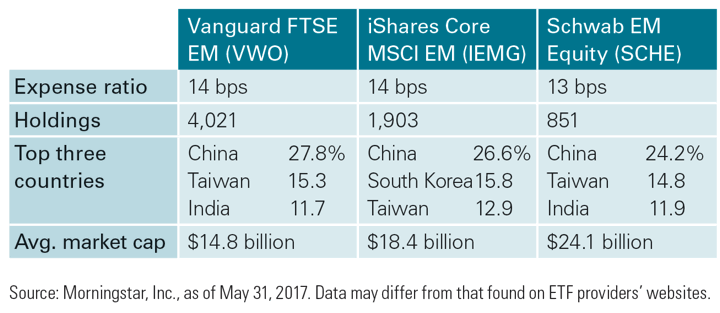The Vanguard Blog has an article Is price everything for ETFs? that reminds us that while low costs may be the most important factor in ETF selection, it is not the only factor. When there are multiple ETFs covering similar asset classes, the DIY investor should dig a bit deeper to get the complete picture.
For example, here is a comparison chart of the Vanguard Emerging Markets ETF (VWO), iShares Core MSCI Emerging Markets ETF (IEMG), and the Schwab Emerging Markets Equity ETF (SCHE). If you compare only with expense ratio, they are all pretty much the same with Schwab being the cheapest by a thin margin.

What’s actually inside? Underneath the ETF wrapper, you’ll see that VWO holds a larger number of companies and the average market cap is smaller at $15 billion. This means that Vanguard’s ETF holds many more of the smaller companies, if that additional diversification interests you. iShares still holds South Korean stocks, whereas Vanguard and Schwab has South Korea as a developed market.
Trade commissions. Transaction costs affect your personal return. You can trade Vanguard ETFs for free with an account direct at Vanguard.com. You can trade Schwab ETFs for free with an account direct at Schwab.com. iShares doesn’t have their own self-directed brokerage arm, but you can trade many iShares ETFs for free at Fidelity.com. You could also go through a broker that offers free trades on everything like Robinhood (no minimum) or Merrill Edge ($50,000+ in assets).
Average bid/ask spread. In addition to commissions, there is also a buy/sell gap where you can lose money. This is less important for gradual buy-and-hold investors, but you still want this gap to be as small as possible. The article doesn’t share this information, but you can look it up at sites like ETF.com, where the respective 45-day historical bid/ask spreads were VWO (0.02%), IEMG (0.02%), and SCHE (0.04%). Schwab has the lowest assets under management and lowest daily volume, making their bid/ask spread wider by a thin margin.
 The Best Credit Card Bonus Offers – 2025
The Best Credit Card Bonus Offers – 2025 Big List of Free Stocks from Brokerage Apps
Big List of Free Stocks from Brokerage Apps Best Interest Rates on Cash - 2025
Best Interest Rates on Cash - 2025 Free Credit Scores x 3 + Free Credit Monitoring
Free Credit Scores x 3 + Free Credit Monitoring Best No Fee 0% APR Balance Transfer Offers
Best No Fee 0% APR Balance Transfer Offers Little-Known Cellular Data Plans That Can Save Big Money
Little-Known Cellular Data Plans That Can Save Big Money How To Haggle Your Cable or Direct TV Bill
How To Haggle Your Cable or Direct TV Bill Big List of Free Consumer Data Reports (Credit, Rent, Work)
Big List of Free Consumer Data Reports (Credit, Rent, Work)
FYI – IEMG and many other iShares ETFs can be traded without commissions on Fidelity’s platform. https://www.fidelity.com/etfs/ishares
Thanks, you’re right, I was getting TD Ameritrade and Fidelity confuse after TDA dropped a lot of their iShares ETFs. Will edit.